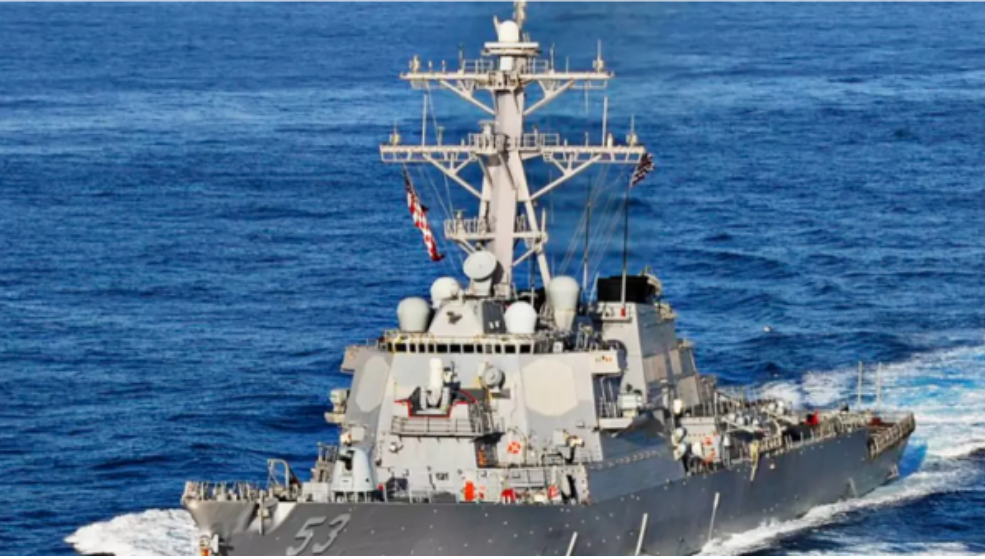India was surprised when the USS John Paul Jones, a 9,000-tonne guided missile destroyer, asserted navigational rights some 130 nautical miles west of the Lakshadweep Islands on April 7, inside India’s exclusive economic zone (EEZ), without requesting prior consent.
Taken aback by the suddenness of the operation, India’s Ministry of External Affairs made a mild protest, saying the operation was unauthorised. It also said its concerns had been conveyed to Washington “through diplomatic channels”.
If India had a choice – that is, if the US Navy made no mention of it – New Delhi would probably have pretended nothing had happened. However, the fact the incident took place less than a month after the first Quad summit and during US presidential climate envoy John Kerry’s visit to New Delhi was too much to ignore.

India and the United States have been part of the chorus chanting about the “free and open Indo-Pacific” in recent years, but they are not birds of a feather flocking together. The decision to challenge India’s EEZ suggests that Washington does not consider millions of square kilometres of water in the Indian Ocean “free and open”.
Otto von Bismarck is famously reported to have said, “Laws are like sausages, it is better not to see them being made.” The UN Convention on the Law of the Sea (Unclos) is probably the longest sausage ever made. It was negotiated for nine years, and understandably compromises were made and ambiguities that could be flexibly interpreted were found.
Almost four decades have passed since the convention was adopted in 1982. The US still has not ratified the convention, yet it behaves as if it is the guardian of maritime law. From October 1, 2019 to September 30, 2020, US forces operationally challenged “28 different excessive maritime claims made by 19 different claimants throughout the world”, according to the Pentagon.
A simple question arises. If the convention is good, why hasn’t the US ratified it? If it is not good, why would the US challenge others in the name of it?
It is no secret Delhi is not happy with China’s growing influence in the Indian Ocean, which India jealously guards as its own backyard. The deadly brawl between Chinese and Indian soldiers in the Galwan Valley in the border areas last year made its trust towards China “profoundly disturbed”, as Indian Foreign Minister Subrahmanyam Jaishankar said.
But when Delhi mimics Washington to tout the “free and open Indo-Pacific”, it almost has a comedic effect. India has more in common with China than with the US when it comes to international maritime law.
For example, like India, China does not accept arbitration on all disputes referred to in Article 298 of the convention. In its protest to the US, India said it believed “the convention does not authorise other states to carry out military exercises or manoeuvres, in particular those involving weapons or explosives, without the consent of the coastal state in the exclusive economic zone and on the continental shelf”.
Like India, China is concerned with foreign military activities in its EEZ. China has criticised America’s high intensity and large scale close-in reconnaissance. China and India are not alone. More than 20 countries in the world have restrictions on foreign military activities in their EEZs, to varying degrees.
A key difference, though, is that Beijing’s response to America’s behaviour is robust, unlike that of Delhi. The US has conducted freedom of navigation operations (Fonops) directed at Indian maritime claims since at least 1992, but “the [Indian] government and navy prefer to remain silent on US operations in the EEZ”, Indian analyst Manoj Joshi wrote in 2019. “There is no record of the Indian Navy having attempted to thwart US Navy ships.”
China’s response ranges from protests and ship-to-ship warnings to interceptions, particularly when American ships enter into the 12-nautical-mile territorial waters off Chinese rocks and islands in the South China Sea. There have been a number of dangerous encounters at sea.
I once asked a senior American naval officer at an international conference how China and the US might prevent accidents that neither wants in the South China Sea. Without hesitation he said, “The Chinese ship commander can say whatever he wants, but don’t sail in my way.”
This is impossible. If American Fonops increase in China’s waters in the South China Sea, an ever-stronger PLA Navy can only become more determined to check them. Therefore, at least in theory, it is only a matter of time before another crisis occurs.
In Kishore Mahbubani’s book Has China Won?, he assumes that by 2050, when the Chinese economy could effectively be twice as large as the US economy, America could withdraw from the western Pacific Ocean and retreat back into its hemisphere and live 11,000km away from China. Maybe. But what would happen before then?
For Beijing, a fundamental problem exists – if the US does not want the water to boil, why does it keep throwing wood into the fire? It is the American ships that come regularly to China’s doorstep and not the other way round.
It is not clear why the US Navy chose to publicise its operation in India’s EEZ at a time when Washington wants Delhi to take its side in its competition with China. It is a useful lesson for India. Expediency might sell in the short term, but it seldom pays off in the long run and, worse still, it might backfire.
Senior Colonel Zhou Bo (ret) is a senior fellow at the Centre for International Security and Strategy at Tsinghua University and a China Forum expert
